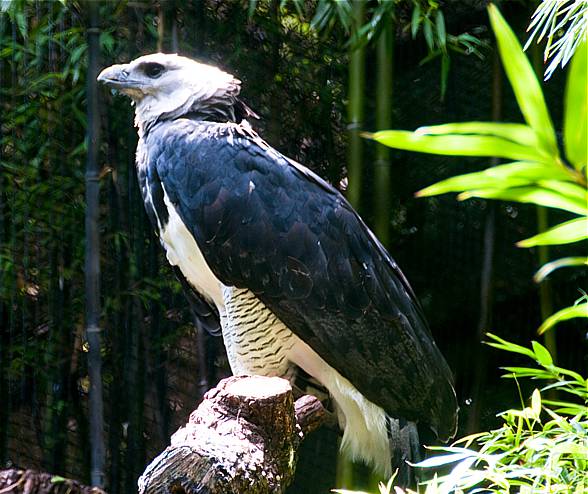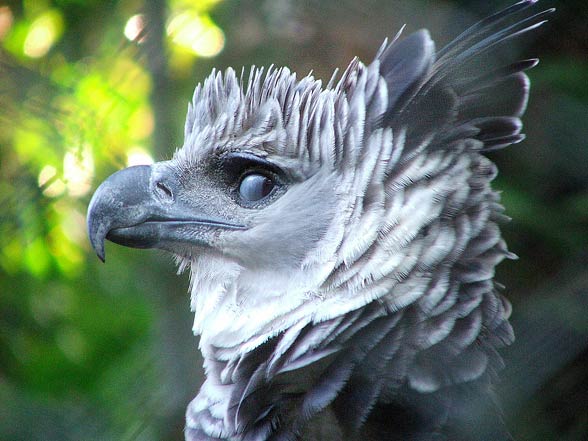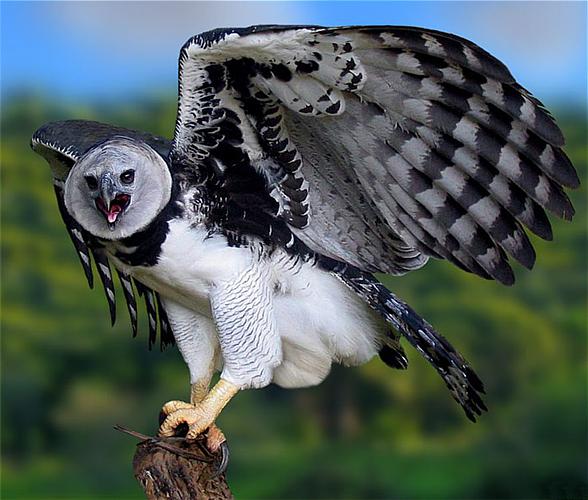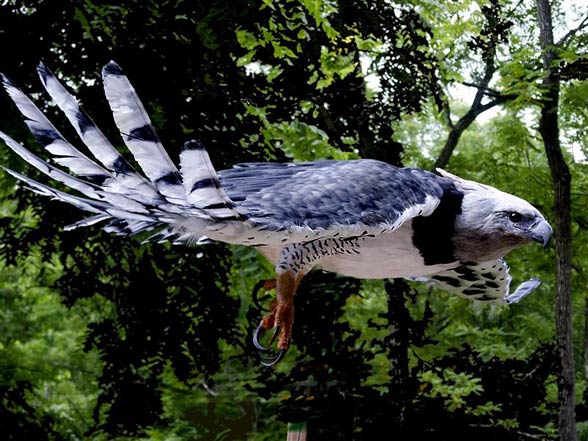Harpy eagle (Harpia harpyja)
Harpies are one of the largest birds of prey. They occur in the rain-forest of South America where they are unrivaled in the air. They hunt large mammals, and their delicacies include monkeys, lazy people and even ants. In defense of their nests, they can attack even a human being. Harpies have the largest talons of all birds of prey, and the strength of their grip is so great that it could crush the human hand. They can lift prey up to equal their own body weight.
Classification
- Kingdom: Animalia
- Phylum: Chordata
- Class: Aves
- Order: Accipitriformes
- Family: Accipitridae
- Subfamily: Harpiinae
- Genus: Harpia
- Species: Harpia harpyja
- Name: harpy eagle, American harpy eagle

Harpy eagle (Harpia harpyja)
Harpies live in the tropical forests of South and Central America. They can be found from southern Mexico to Argentina. The harpy eagle is one of the largest and most powerful predatory birds that currently live on Earth. These birds are usually less than 900 m above sea level (rarely up to 2000 m above sea level).
As with all birds of the Accipitridae family female of harpies are larger than males. These birds have dark gray plumage on the back, the underside is white, and the head is light-gray. Both the harpy male and the female have a feather tip on their heads. The young harpies have white plumage that gets dark with age.
The harpy eagle is sometimes called the American Harpy Eagle.

The biggest harpy
The largest harpy in captivity – Jezebel – weighed 12.3 kg (27 lb). This is not representative, however, due to the availability of food. In the wild, these birds have to hunt, so they lose more energy and are lighter. As with gorillas – gorillas in captivity eat a lot more and lack of activity causes that the weight of record individuals is even 30% – 40% higher than in the wild (160-225 kg vs. 270 kg in captivity).
Is the great harpy the largest bird of prey in the world?
This is a complex question and it is difficult to answer it unambiguously. The wingspan of harpies’ from 176 to 224 cm, is relatively small, considering the weight of these birds. Some eagles overtake them in this area – see the largest eagles.
Somewhat longer than the harpy can be the Philippine eagle (Pithecophaga jefferyi) – a species of a large bird of prey living in the Philippines – although the average length of harpies is greater. The Steller’s sea eagle (Haliaeetus pelagicus) exceeds the harpy with its average weight. On the other hand, the harpies reach the highest weight (record individuals) and are the strongest birds of prey – see the claws.
Many readers may wonder – how is it, after all, the condor is bigger and heavier? Yes, but condor is not a bird of prey, but a scavenger.

What is the harpy hunting for?
Typical harpies’ victims are animals weighing a few kilograms, although these birds prefer victims weighing over 7 kg. The harpies feed mainly on arboreal mammals (sloths, kinkajous, coatis, tayras, monkeys, opossums, anteaters, armadillos), but also terrestrial mammals (agouti, bush dogs), birds (macaws, toucans) and reptiles. They hunt for victims whose weight is several kilograms. The hunting territories of harpies are usually 25 km² (16 mi²).
Harpy attributes – sight and claws
Harpy’s talons reach a length of 8 to 13 cm (3.15 – 5.12 in). The harpy paw is larger than the male hand, and its strength is so large that it can crush the bones (pressure 42 kgf/cm²). Harpy has excellent eyesight – it can see a coin-sized object from a distance of 200 m (656 ft). The males are smaller than females, they are more maneuverable and faster – they reach speeds of up to 80 km / h (50 mph).

Nest and breeding
Harpy builds a nest at high altitude – often located more than 40 m (131 ft) above the ground in the crowns of tall trees in rainforests. The female usually lays 1-2 eggs. Mating takes place every 2-3 years.
Is the harpy under protection?
Harpies, as a rare and endangered species, are under strict protection. The number of harpies decreases as a result of the destruction of the natural environment and poaching. Panama recognized the harpy of 2002 as the symbol of her country. The harpies’ population is estimated below 50,000 individuals.

Detailed information / size
- Body length: 5–107 cm (2 ft 10 in–3 ft 6 in)
- Wingspan: 176 to 224 cm (5 ft 9 in to 7 ft 4 in)
- Tail length: 37–42 cm (1 ft 3 in – 1 ft 5 in)
- Talons: 8 – 13 cm (3.15 – 5.12 in)
- Weight:
- male: 4 to 4.8 kg (8.8 to 10.6 lb)
- female: 6 to 9 kg (13 to 20 lb)
- The record weight of the harpy in captivity – the harp “Jezebel”, weighed 12.3 kg (27 lb)
- Lifespan: 30 years
The Harpiinae is a bird of prey subfamily. There are 3 genera in the subfamily:
Species
- Genus Morphnus
- Crested eagle (M. guianensis)
- Genus Harpia
- Harpy eagle (H. harpyja)
- Genus Harpyopsis
- Papuan eagle (H. novaeguineae)

Recommended
- Argentavis
- Eagles
- Animals records
- Largest eagles Top10
- Largest birds of prey Top10
- Haast’s eagle
- Bald eagle
- Black eagle
- Steller’s sea eagle
- Philippine eagle
- Crowned eagle
- Martial eagle
- Wedge-tailed eagle
- Eastern imperial eagle
- Steppe eagles
- Bearded vulture
- Fastest animals – Top 10
- Fastest birds – Top 10
- Highest (Top) flying bird – Top 10
- Largest and heaviest birds


















